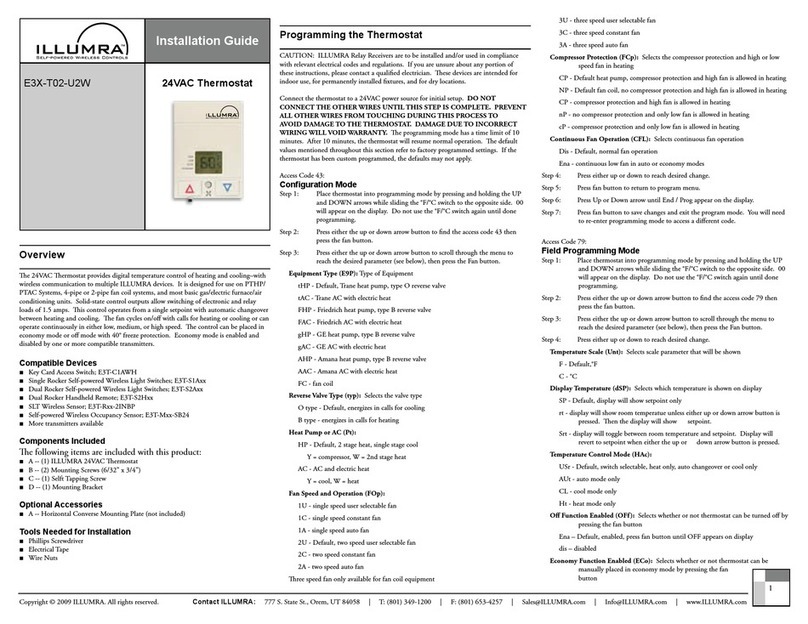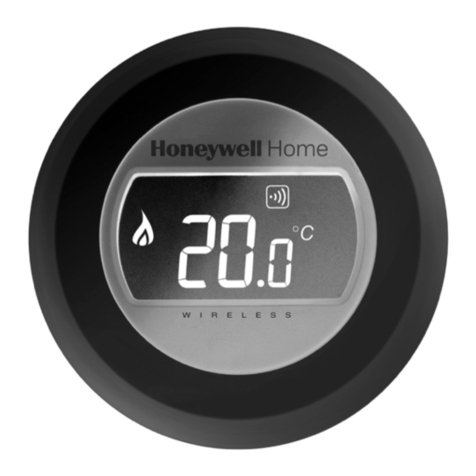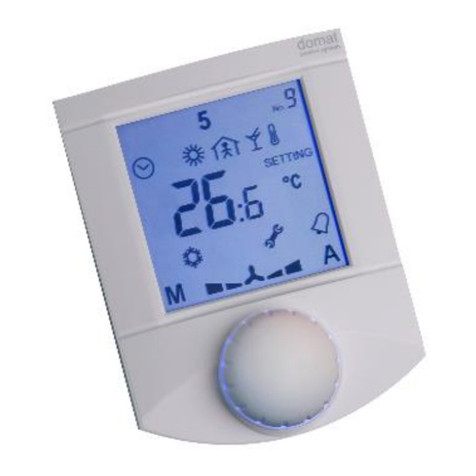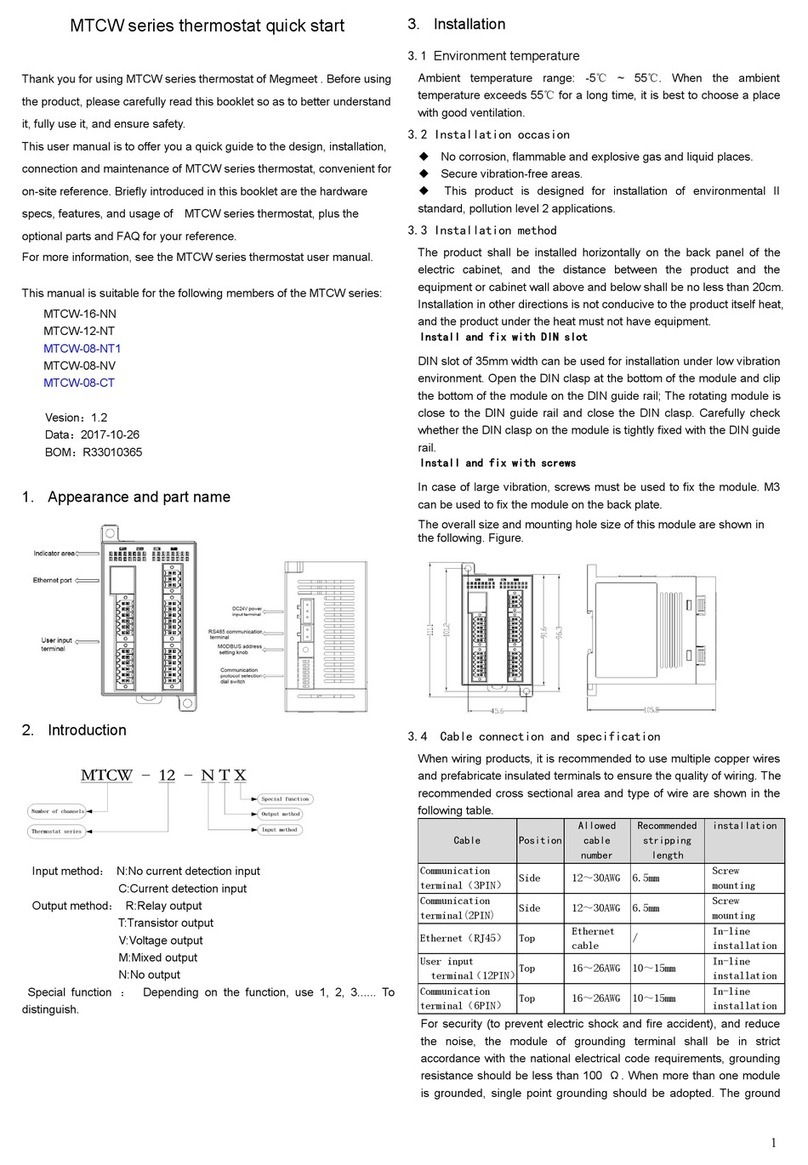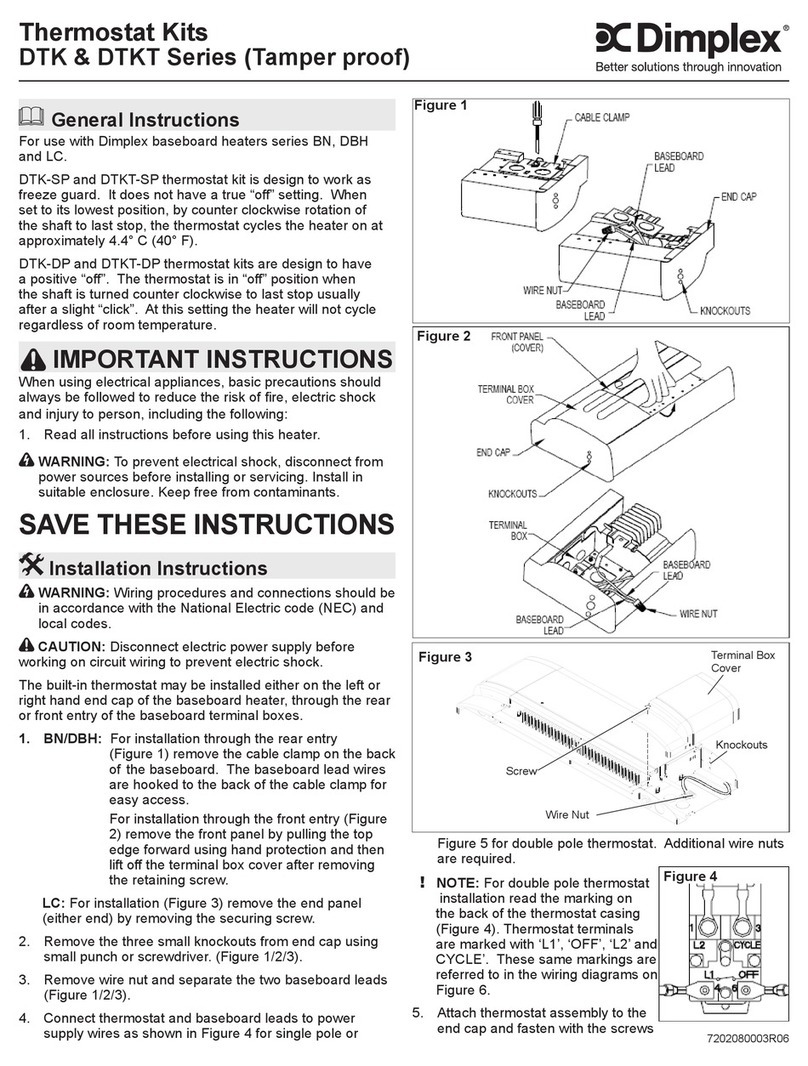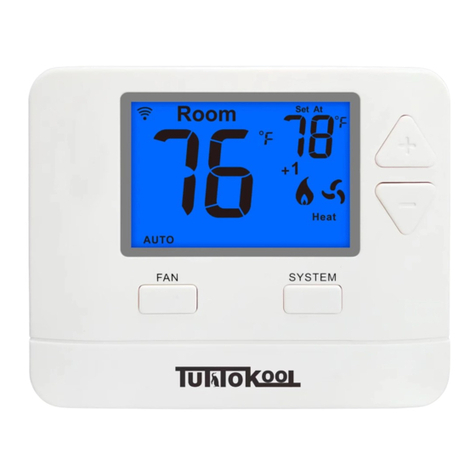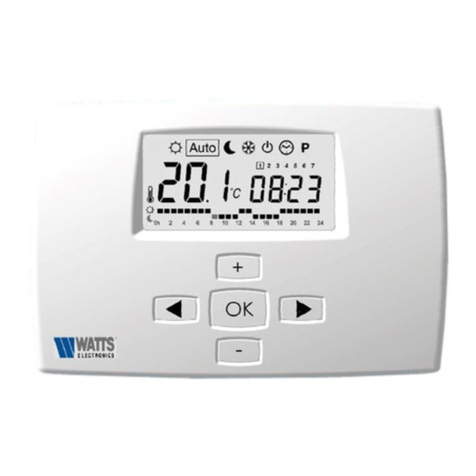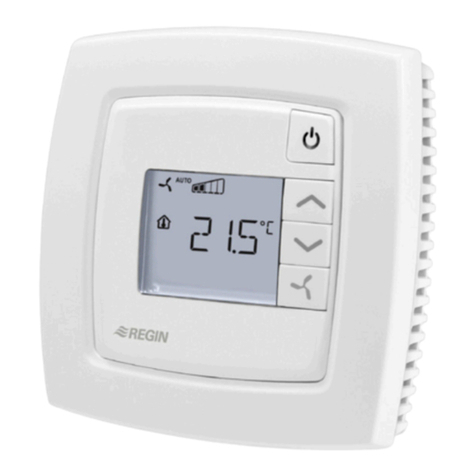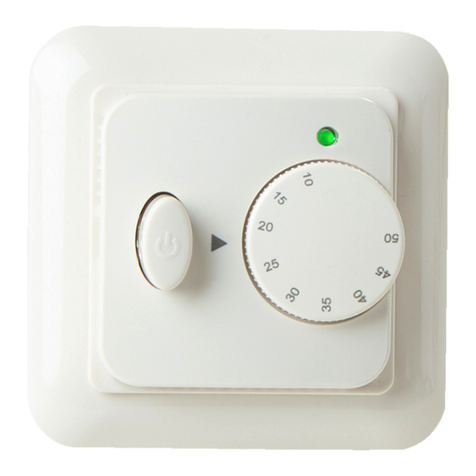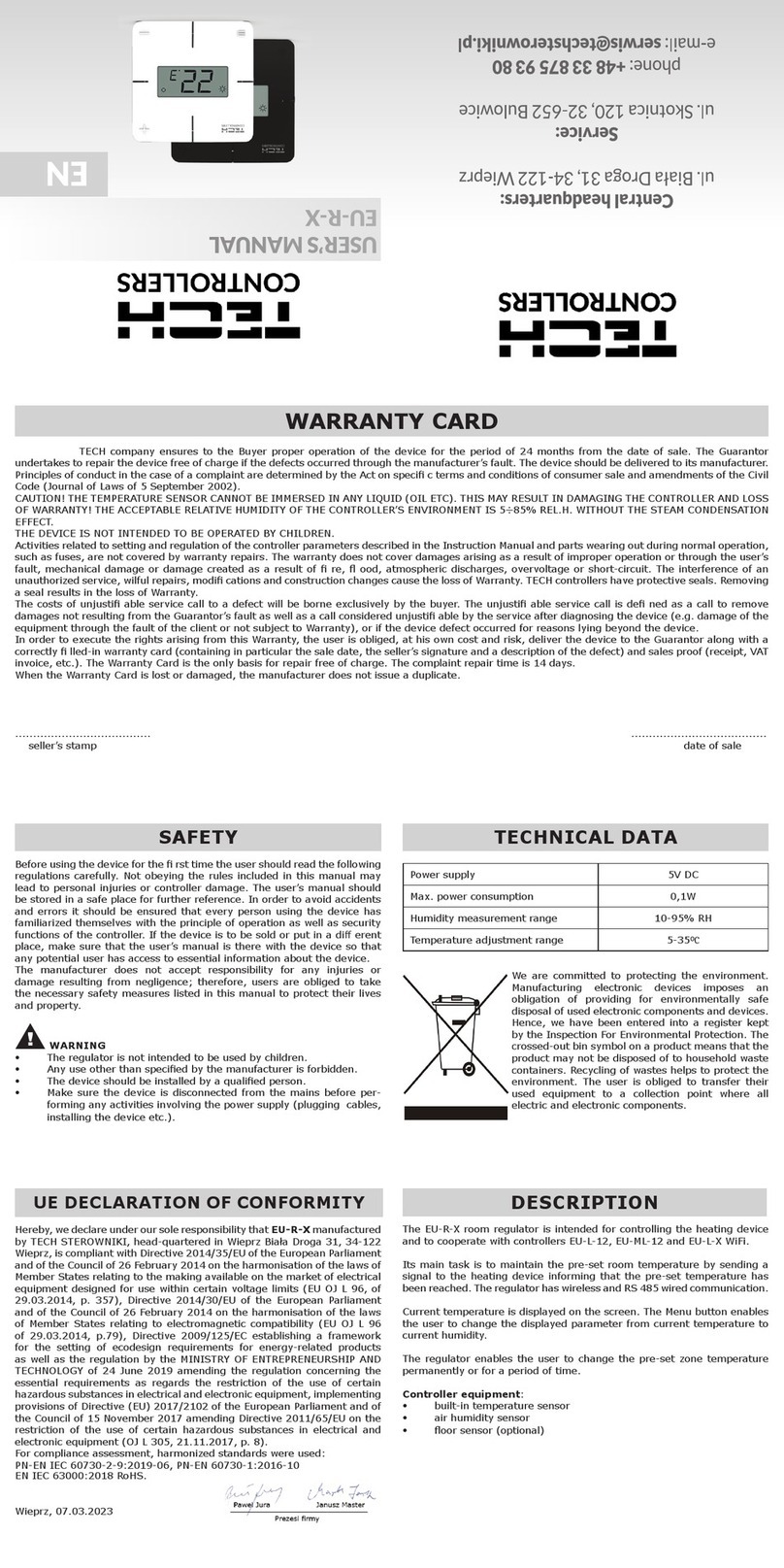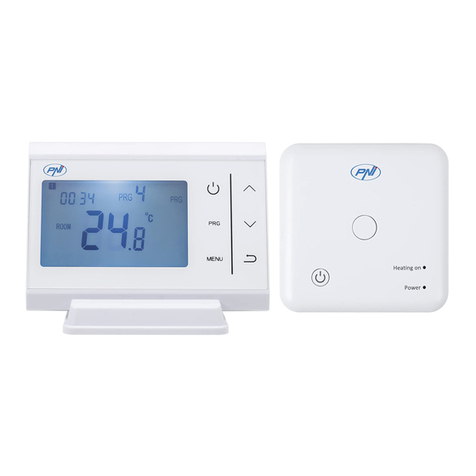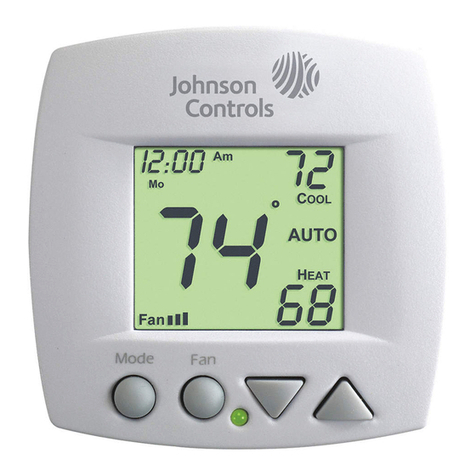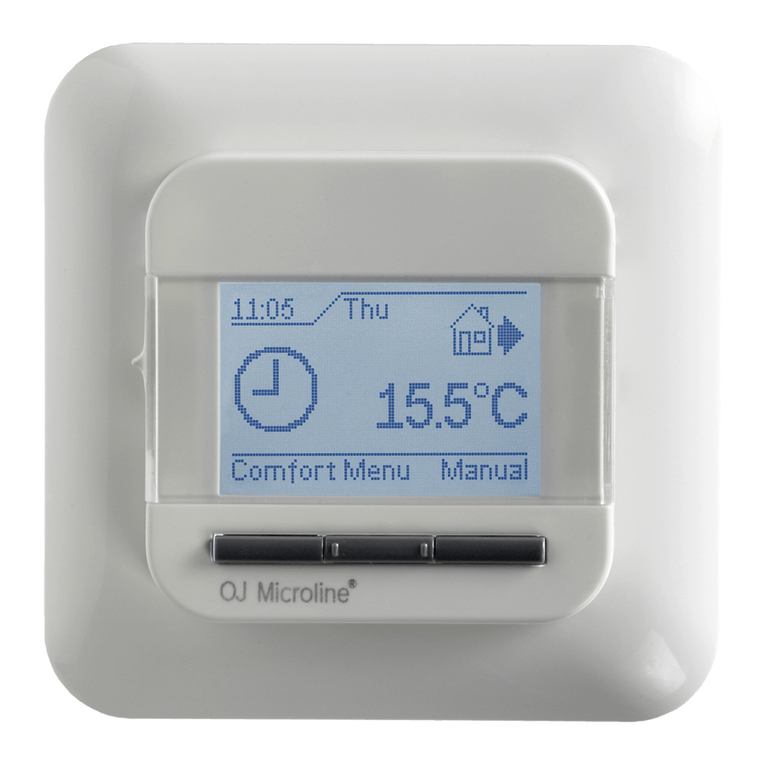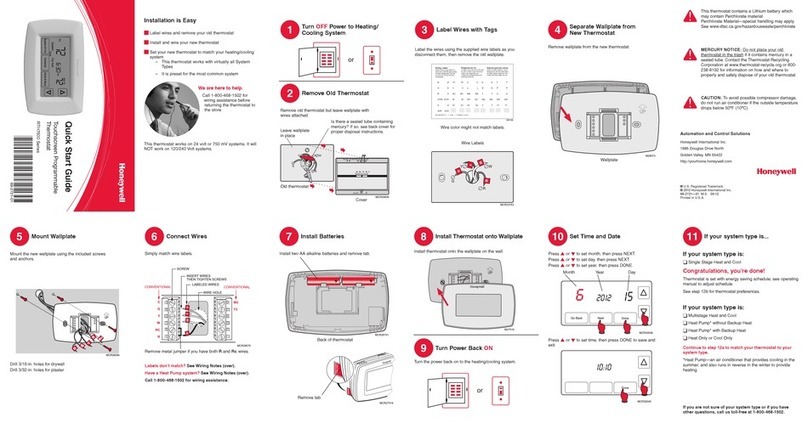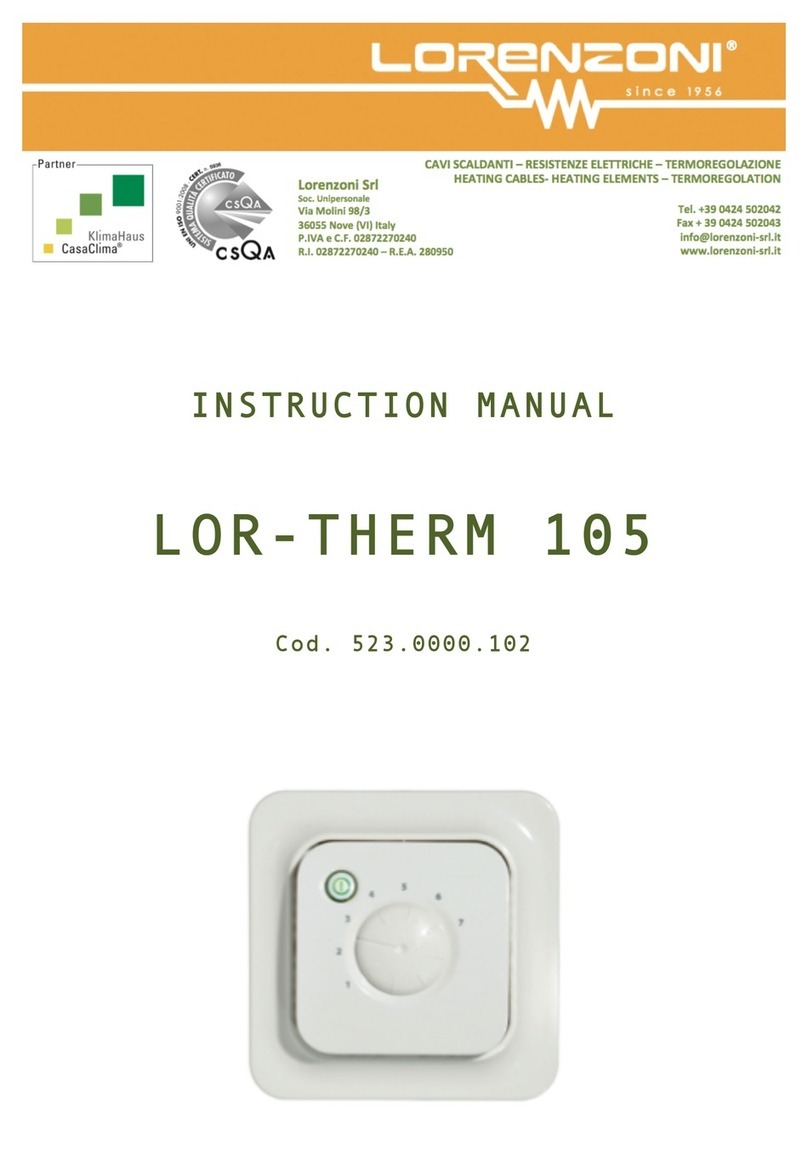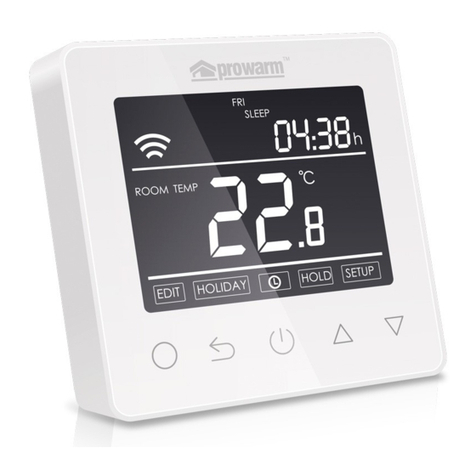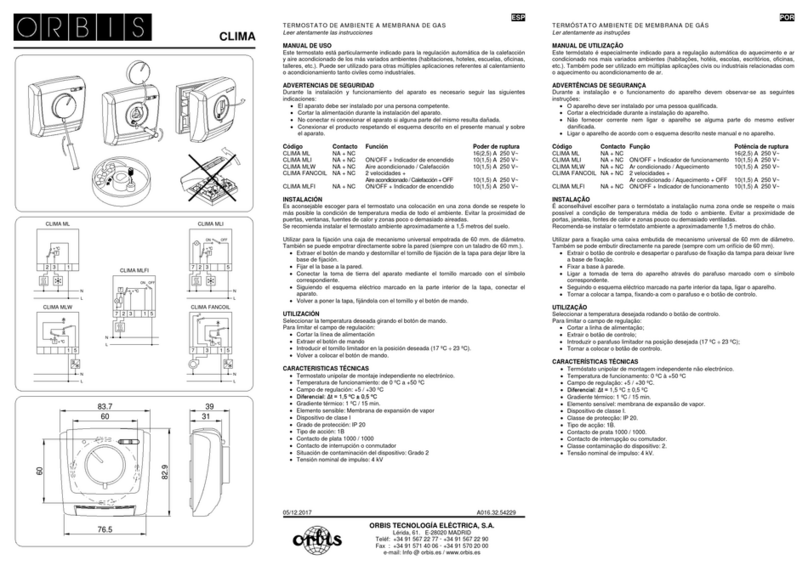Illumra E3X-T02-U2W User manual

1
Copyright © 2009 ILLUMRA. All rights reserved. Contact ILLUMRA: T: (801) 349-1200 | F: (801) 653-4257 | [email protected] | www.ILLUMRA.com AHD0215B
Installation Guide
E3X-T02-U2W 24VAC Thermostat
Overview
e 24VAC ermostat provides digital temperature control of heating and cooling–with
wireless communication to multiple ILLUMRA devices. It is designed for use with most
basic gas/electric furnace/air conditioning units, PTHP/PTAC Systems, 4-pipe, or 2-pipe
fan coil systems. Solid-state control outputs allow switching of electronic and relay loads
of 1.5 amps. is control operates from a single setpoint with automatic changeover
between heating and cooling. e fan cycles on/off with calls for heating or cooling or can
operate continuously in either low, medium, or high speed. e control can be placed in
economy mode or off mode with 40° freeze protection. Economy mode is enabled and
disabled by one or more compatible transmitters.
Compatible Devices
Key Card Access Switch; E3T-C1AWH
Single Rocker Self-powered Wireless Light Switches; E3T-S1Axx
Dual Rocker Self-powered Wireless Light Switches; E3T-S2Axx
Dual Rocker Handheld Remote; E3T-S2Hxx
SLT Wireless Sensor; E3T-Rxx-2INBP
Self-powered Wireless Occupancy Sensor; E3T-Mxx-SB24
More transmitters available
Components Included
e following items are included with this product:
A -- (1) ILLUMRA 24VAC ermostat
B -- (2) Mounting Screws (6/32” x 3/4”)
C -- (1) Self Tapping Screw
D -- (1) Mounting Bracket
Optional Accessories
A -- Horizontal Mounting Plate (not included)
Tools Needed for Installation
Phillips Screwdriver
Electrical Tape
Wire Nuts
■
■
■
■
■
■
■
■
■
■
■
■
■
■
■
Programming the Thermostat
CAUTION: ILLUMRA Relay Receivers are to be installed and/or used in compliance
with relevant electrical codes and regulations. If you are unsure about any portion of
these instructions, please contact a qualified electrician. ese devices are intended for
indoor use, for permanently installed fixtures, and for dry locations.
Connect the thermostat to a 24VAC power source for initial setup. DO NOT
CONNECT THE OTHER WIRES UNTIL THIS STEP IS COMPLETE. PREVENT
ALL OTHER WIRES FROM TOUCHING DURING THIS PROCESS TO
AVOID DAMAGE TO THE THERMOSTAT. DAMAGE DUE TO INCORRECT
WIRING WILL VOID WARRANTY. e programming mode has a time limit of 10
minutes. After 10 minutes, the thermostat will resume normal operation. e default
values mentioned throughout this section refer to factory programmed settings. If the
thermostat has been custom programmed, the defaults may not apply.
NOTE: For programming large numbers of devices, an accessory is available to copy
settings from one device to another. Contact ILLUMRA for details.
Access Code 43:
Conguration Mode
Step 1: Place thermostat into programming mode by pressing and holding the UP
and DOWN arrows while sliding the °F/°C switch to the opposite side. 00
will appear on the display. Do not use the °F/°C switch again until done
programming.
Step 2: Press either the up or down arrow button to find the access code 43 then
press the fan button.
Step 3: Press either the up or down arrow button to scroll through the menu to
reach the desired parameter (see below), then press the Fan button.
Exit Menu (Ext):
Equipment Type (E9P): Type of Equipment
tHP - Default, Trane heat pump, type O reverse valve
tAC - Trane AC with electric heat
FHP - Friedrich heat pump, type B reverse valve
FAC - Friedrich AC with electric heat
gHP - GE heat pump, type B reverse valve
gAC - GE AC with electric heat
AHP - Amana heat pump, type B reverse valve
AAC - Amana AC with electric heat
FC - fan coil
Reverse Valve Type (typ): Selects the valve type
O type - Default, energizes in calls for cooling
B type - energizes in calls for heating
Heat Pump or AC (Pt):
HP - Default, 2 stage heat, single stage cool
Y = compressor, W = 2nd stage heat
AC - AC and electric heat
Y = cool, W = heat
Fan Speed and Operation (FOp):
1U - single speed user selectable fan
1C - single speed constant fan
1A - single speed auto fan
2U - Default, two speed user selectable fan
2C - two speed constant fan
2A - two speed auto fan
ree speed fan only available for fan coil equipment
3U - three speed user selectable fan
3C - three speed constant fan
3A - three speed auto fan
Compressor Protection (FCp): Selects the compressor protection and high or low
speed fan in heating
CP - Default heat pump, compressor protection and high fan is allowed in heating
NP - Default fan coil, no compressor protection and high fan is allowed in heating
CP - compressor protection and high fan is allowed in heating
nP - no compressor protection and only low fan is allowed in heating
cP - compressor protection and only low fan is allowed in heating
Continuous Fan Operation (CFL): Selects continuous fan operation
Dis - Default, normal fan operation
Ena - continuous low fan in auto or economy modes
Step 4: Press either up or down to reach desired change.
Step 5: Press fan button to return to program menu.
Step 6: Press Up or Down arrow until End / Prog appear on the display.
Step 7: Press fan button to save changes and exit the program mode. You will need
to re-enter programming mode to access a different code.
Access Code 79:
Field Programming Mode
Step 1: Place thermostat into programming mode by pressing and holding the UP
and DOWN arrows while sliding the °F/°C switch to the opposite side. 00
will appear on the display. Do not use the °F/°C switch again until done
programming.
Step 2: Press either the up or down arrow button to find the access code 79 then
press the fan button.
Step 3: Press either the up or down arrow button to scroll through the menu to
reach the desired parameter (see below), then press the Fan button.
Step 4: Press either up or down to reach desired change.
Exit Menu (Ext):
Temperature Scale (Unt): Selects scale parameter that will be shown
F - Default,°F
C - °C
Display Temperature (dSP): Selects which temperature is shown on display
SP - Default, display will show setpoint only
rt - display will show room temperatue unless either up or down arrow button is
pressed. en the display will show setpoint.
Srt - display will toggle between room temperature and setpoint. Display will
revert to setpoint when either the up or down arrow button is pressed.
Temperature Control Mode (HAc):
USr - Default, switch selectable, heat only, auto changeover or cool only
AUt - auto mode only
CL - cool mode only
Ht - heat mode only
Off Function Enabled (OFf): Selects whether or not thermostat can
be turned off by pressing the fan button

2
Copyright © 2009 ILLUMRA. All rights reserved. Contact ILLUMRA: T: (801) 349-1200 | F: (801) 653-4257 | [email protected] | www.ILLUMRA.com AHD0215B
Ena – Default, enabled, press fan button until OFF appears on display
dis – disabled
Economy Function Enabled (ECo): Selects whether or not thermostat can be
manually placed in economy mode by pressing the fan button
Ena – Default, enabled, press fan button until Eco and
ECON appears on display
dis – disabled
Comfort Setpoint (CS): Selects setpoint default temperature when thermostat
powers up or returns to comfort mode from economy mode
72.0°F (22.0°C) Default
Programmable Range: 60.0°F to 85.0°F (15.5°C to 29.5°C)
Cooling Limit (LC): Selects minimum room temperature in cooling
65.0°F (18.5°C) Default
Programmable Range: 60.0°F to 85.0°F (15.5°C to 29.5°C)
Heating Limit (LH): Selects maximum room temperature in heating
85.0°F (29.5°C) Default
Programmable Range: 60.0°F to 85.0°F (15.5°C to 29.5°C)
Freeze Protection (FP): Selects freeze protection enabled or disabled
Ena – Default, enabled at 40°F
dis – disabled
Fan Purge Timer (FPt): Selects the amount of time the fan will continue to run
after a heating or cooling call.
30 seconds Default
Programmable Range: 0 (Off) to 180 seconds (3 minutes), in 10 second
increment
Clear Logged Data (CLr): Selects whether or not the logged run time data will be
reset to 0’s
no – Default, no reset
Yes – reset
Setback Ramping (Sbr): Selects setback function to step back to economy
setpoints or to go directly to economy setpoints.
dis - Default, disabled, directly to economy setpoint
Ena – enabled, ramps to economy setpoints
OFf - directly to Off mode
Ramping Setback Timer (rSt): After setback is initiated, selects the amount
of time the setpoint will be stepped back by the degrees per setback
Example: if both parameters are defaulted, the thermostat will step back
1° per every 30 minutes until either the economy cooling limit (EC) or
the economy heating limit (EC) is reached.
30 minutes Default
Programmable Range: 1 minute to 720 minutes (12 hours), in 15 minute
increment
Degrees Per Setback (dPs): Selects the number of degrees per time period that the
setpoint will be stepped back
1° Default
Programmable Range: 0°F to 3°F, in 0.5°F increments
Economy Cooling Limit (EC): When in economy or remote setback mode, selects
the highest room temperature before cooling turns on. Cooling turns off
when temperature falls below EC value.
85.0°F (29.5°C) Default
Programmable Range: 72.0°F to 99.0°F (22.0°C to 37.0°C), in 0.5°F increments
Economy Heating Limit (EH): When in economy or remote setback mode, selects
the lowest room temperature before heating turns on. Heating turns off when
temperature rises above EH value.
60.0°F (15.5°C) Default
Programmable Range: 41.0°F to 72.0°F (5.0°C to 22.0°C), in 0.5°F
increments
Fan Refresh Frequency (FrF): Selects how often the low fan will operate for a fan refresh 0
hours Default, disabled
Programmable Range: 0 hours to 24 hours
Fan Refresh Duration (Frd): Selects the length of time the low fan will operate during a
fan refresh
1 minute Default
Programmable Range: 1 minute to 45 minutes
Cycle Rate Timer (crt): Limits the number of heat/cool cycles per hour
6 cycles per hour Default, heat pump
8 cycles per hour Default, fan coil
Programmable Range: 0 (Off) to 12 cycles per hour, heat pump
Programmable Range: 0 (Off) to 24 cycles per hour, fan coil
Differential (Dif): Selects the minimum room temperature above or below setpoint when
heating or cooling will turn on or off.
0.4°F (0.2°C) Default
Programmable Range (°F): 0.2, 0.4, 0.6, 0.8, 1.0, 1.2
Programmable Range (°C): 0.1, 0.2, 0.3, 0.4, 0.5, 0.6
Setpoint Hold Timer (SH): Selects a time limit that the occupant’s setpoint will be saved,
when in economy mode.
0 hours Default, disabled
Programmable Range: 0 to 24 hours
Fan Hold Timer (HFt): Selects a time limit the high and low fans will operate before
automatically returning to auto mode.
0 hours Default, disabled
Programmable Range: 0 to 24 hours
Shutdown Delay (Sdd): Selects the amount of time delay between remote shutdown
signal and the thermostat going into shutdown mode.
0 seconds Default, immediate
Programmable Range: 0 seconds to 200 minutes
Step 5: Press fan button to return to program menu.
Step 6: Press Up or Down arrow until End / Prog appear on the display.
Step 7: Press fan button to save changes and exit the program mode. You will need to
re-enter programming mode to access a different code.
Access Code 92:
Restore Factory Presets
Step 1: Place thermostat into programming mode by pressing and holding the UP
and DOWN arrows while sliding the °F/°C switch to the opposite side. 00
will appear on the display. Do not use the °F/°C switch again until done
programming.
Step 2: Press either the up or down arrow button to find the access code 92 then press
the fan button.
Step 3: All and Erase will appear on the display. Press the fan button again to rest to
factory defaults.
Step 4: Press Up or Down arrow until End / Prog appear on the display.
Step 5: Press fan button to save changes and exit the program mode. You will
need to re-enter programming mode to access a different code.
NOTE: is procedure does not affect the stored switches in memory. See the
“Programming the Radio Receiver” section for methods to clear this
memory.
Installation
Junction box mounting is highly recommended. For optimal radio performance do
not mount or place the receivers close to the floor or inside a metal housing.
INSTALLATION OPTION A:
Heat Pump Conguration
Step 1: Read all steps for this option before taking any action to install
thermostat.
Step 2: WARNING: To avoid risk of fire, shock, or death, TURN OFF POWER
at circuit breaker or fuse and verify that it is OFF before installation
begins. Make sure that it remains OFF until installation is complete.
Step 3: If retrofitting old thermostat, remove old thermostat, carefully noting the
wire connections on the old unit. Record wire color and terminal legends
(Cable wire color for Control Feed, Load Feed, Common, Auxiliary
Heat, Compressor, Low Fan, High Fan, and Reversing Valve). Refer to
Table A.
Step 4: Install mounting bracket to the junction box with provided mounting
screws.
Step 5: Wire thermostat according to function as shown in Figure A.
Step 6: Push wires into junction box. Rest bottom of thermostat on mounting
tabs in mounting plate. Push top of thermostat towards wall and secure
into place with self-tapping screw.
Step 7: Turn power on.
INSTALLATION OPTION B:
4-Pipe Fan Coil Conguration
Step 1: Read all steps for this option before taking any action to install
thermostat.
Step 2: WARNING: To avoid risk of fire, shock, or death, TURN OFF POWER
at circuit breaker or fuse and verify that it is OFF before installation
begins. Make sure that it remains OFF until installation is complete.
Step 3: If retrofitting old thermostat, remove old thermostat, carefully noting
the wire connectinos on the old unit. Record wire color and terminal
legeneds (Cable wire color for Control Feed, Load Feed, Common,
Auxiliary Heat, Compressor, Low Fan, High Fan, and Reversing Valve).
Refer to Table A.
Step 4: Install mounting bracket to the junction box with provided mounting
screws.
Step 5: Wire thermostat according to function as shown in Figure B. NOTE: If
the mechanical system has only two fan speeds: Green - Low Fan, Violet
- High Fan, Orange - Not used.
Step 6: Push wires into junction box. Rest bottom of thermostat on mounting
tabs in mounting plate. Push top of thermostat towards wall and secure
into place with self-tapping screw (included).
Step 7: Turn power On.
INSTALLATION OPTION C:
2-Pipe Fan Coil Conguration
NOTE: Continuous fan is not available on 2-Pipe with aquastat systems.
Continuous fan is available on 2-Pipe with electric heat
systems.

3
Copyright © 2009 ILLUMRA. All rights reserved. Contact ILLUMRA: T: (801) 349-1200 | F: (801) 653-4257 | [email protected] | www.ILLUMRA.com AHD0215B
Step 1: Follow instructions for a 4-Pipe installation but using Figure C for 2-Pipe Fan Coil with Aquastat or Figure D for 2-Pipe
Fan Coil with Electric Heat.
Step 2: Push wires into junction box. Rest bottom of thermostat on mounting tabs in mounting plate. Push top of thermostat
towards wall and secure into place with self-tapping screw (included).
Step 3: Turn power On.
Programming the Radio Receiver
e thermostat can be configured to operate with many ILLUMRA transmitters. Depending on the transmitter type and the intended
application, the thermostat will need to be programmed to operate in Rocker Mode, Momentary Mode, Toggle Mode, or Scene Mode.
Multiple modes can be used with one thermostat. For transmitter installation instructions, see appropriate installation guide. Select the
desired Learn Mode below to program the thermostat.
CLEAR MODE:
Clearing the Switch Memory
In order the clear the switch memory within the thermostat, use the following steps:
Step 1: Press and hold the UP and DOWN butttons until CLR appears on the display (approximately 10 seconds). is will delete
all associated transmitters from the memory.
LEARN MODE 0:
Rocker Mode - Wireless Switch Control of Thermostat
Rocker Mode is usually used with ILLUMRA Wireless Light Switches. e thermostat goes into occupied mode when the top of the
rocker switch is pressed and unoccupied mode when the bottom of the rocker switch is pressed.
Step 1: Place the thermostat into Learn Mode by pressing and holding the UP and DOWN butttons until LRN appears on the
display (approx. 5 seconds). e display will alternate between LRN and 0 indicating that it is in Learn Mode 0 - Rocker
Mode.
Step 2: Press one of the rockers on the ILLUMRA Wireless Light Switch. e display on the thermostat will briefly display ADD
indicating that it has added that transmitter.
Step 3: e display will resume alternating between LRN and 0 - add more transmitters as desired for this mode (up to 30). e
small digit on the display will indicate the number of receivers in memory for each mode.
Step 4: To delete a transmitter from the thermostat, press the wireless light switch again. e display on the thermostat will briefly
display DEL indicating that it has deleted that transmitter.
Step 5: Exit Learn Mode by pressing and holding the UP and DOWN buttons until LOC appears on the display or wait 30
seconds to normal operating mode. is indicates that all learned transmitters have been locked into memory on the
thermostat.
NOTE: ese steps are also used for Manual On/Auto Off - when learning a wireless occupancy sensor.
LEARN MODE 1:
Momentary Mode - Keycard Switch Control of Thermostat
Momentary Mode is used with ILLUMRA Wireless Key Card Switches. e thermostat will be in occupied mode when the key card is
inserted and unoccupied when the key card is removed.
Step 1: Place the thermostat into Learn Mode by pressing and holding the UP and DOWN butttons until LRN appears on the
display. e display will alternate between LRN and 0 indicating that it is in Learn Mode 0.
Step 2: Press and release the UP button. e display will alternate between LRN and 1, indicating that it is in Learn Mode 1
- Momentary Mode.
Step 3: Insert a key card into an ILLUMRA Key Card Access Switch. e display on the thermostat will briefly display ADD
indicating that it has added that transmitter.
Step 4: e display will resume alternating between LRN and 1 - add more transmitters as desired for this mode.
Step 5: To delete a transmitter from the thermostat, remove the key card (if inserted) of a learned switch and insert it again. e
display on the thermostat will briefly display DEL indicating that it has deleted that transmitter from memory.
Step 6: Exit Learn Mode by pressing and holding the UP and DOWN buttons until LOC appears on the display or wait 30
seconds to normal operating mode. is indicates that all learned transmitters have been locked into memory on the
thermostat.
NOTE: ese steps are also used for Auto On/Auto Off - Occupancy Sensor Control.
LEARN MODE 2:
Toggle Mode
Toggle Mode is available for future product releases.
Step 1: Place the thermostat into Learn Mode by pressing and holding the UP and DOWN butttons until LRN appears on the
display. e display will alternate between LRN and 0 indicating that it is in Learn Mode 0.
Step 2: Press and release the UP button. e display will alternate between LRN and 1, indicating that it is in Learn Mode 1
- Momentary Mode.
Step 3: Press and release the UP button. e display will alternate between LRN and 2, indicating that it is in Learn Mode 2
- Toggle Mode.
Step 4: Press the transmit button on the desired transmitter. e display on the thermostat will briefly display ADD indicating
that it has added that transmitter.
Step 5: e display will resume alternating between LRN and 2 - add more transmitters as desired for this mode.
Step 6: To delete a transmitter from the thermostat, press the learned transmit button again. e display on the thermostat will
briefly display DEL indicating that it has deleted that transmitter.
Step 7: Exit Learn Mode by pressing and holding the UP and DOWN buttons until LOC appears on the display or wait 30
seconds to normal operating mode. is indicates that all learned transmitters have been locked into memory on the
thermostat.
LEARN MODE 3:
Scene Mode - For Future Product Releases
Specications
E3X-T02-U2W
50 to 150 feet (typical)
315 MHz
24 VAC
1.5 amp/circuit
32.0°F to 99.9°F (0.0°C to 37.7°C)
60°F to 85°F (15.5°C to 29.5°C)
14°F to 131°F (-10°C to 55°C)
-4°F to 131°F (-20°C to 55°C)
Every 5 seconds
Liquid Crystal Display (LCD)
Selectable: Auto Cycle, Low, Medium, High, Economy, Off
Stores up to 30 switch IDs
+/- 1°F (0.5°C)
1 Heat and 1 Cool circuit, Heat pump reversing valve circuit
3.5 x 5.0 x 1.5 inches
FCC (U.S. SZV-TCM2XXC), IC (Canada 5713A-TCM2XXC)
Range
Frequency
Input Voltage
Max Loads
Temperature Monitor Range
Temperature Set Point Range
Operating Temperature
Storage Temperature
Sampling Rate
Display Format
Fan Control
Memory
Accuracy
Heat/Cool Control
Dimensions
Radio Certications
Warranty
Please refer to www.ILLUMRA.com for updated warranty information

4
Copyright © 2009 ILLUMRA. All rights reserved. Contact ILLUMRA: T: (801) 349-1200 | F: (801) 653-4257 | [email protected] | www.ILLUMRA.com AHD0215B
Tables / Wiring Diagrams
Table A:
NOTE: is table is provided for reference and is not intended to match every situation. Multiple installation options are available.
Wiring connections should be made by a qualified HVAC Contractor. If unsure about wire colors or terminal functions,
contact a qualified HVAC contractor. If connections are not made properly, damage to equipment or property could result.
Conventional HVAC Systems
Commonly
Used Wiring
Terminal
Designators
Possible
Wire Color
Possible Signal
Names/Functions Comments
C Black 24VAC Common From one side of the 24VAC transformer, usually
called the common side.
R or V Red 24VAC Hot
From other side of the 24Vac transformer, usually
called the hot side. The thermostat may connect this
terminal with W (call for heat) or Y (call for cool), if RH
and RC are not used/available. Some thermostats
also use this to supply power to themselves.
RH or 4 Red 24VAC hot usually used
for call for heat
Functions as the source of power for the W terminal.
The thermostat usually connects this terminal with W
when it calls for heat.
RC Red 24VAC hot usually used
for call for cool
Functions as the source of power for the Y terminal.
The thermostat usually connects this terminal with Y
when it calls for heat.
G Green Activate blower fan The fan switch on the thermostat usually connects this
terminal with R when it is in the ON position.
W or W1 or W2 White Call for heat
The thermostat usually connects this terminal with R
or RH when it calls for heat. The thermostat usually
connects this terminal with G when the fan switch is
set to AUTO. Some thermostats require a jumper
from W to Y if a heat pump is used. Other thermostats
might use this as second-stage heating. Sometimes
W2 designates auxiliary heating in systems that use
heat pumps.
Y Yellow Call for cool
The thermostat usually connects this terminal with R
or RC when it calls for heat. The thermostat usually
connects this terminal with G when the fan switch is
set to AUTO. Could also be for cooling of rst-stage
heating on a heat pump.
S1 and S2 Varies Outside air temperature
display
Used to display the outside air temperature on some
digial thermostats
Systems with heat pumps or staged heating/cooling sub-systems
Commonly
Used Wiring
Terminal
Designators
Possible
Wire Color
Possible Signal
Names/Functions Comments
C Black 24VAC Common From one side of the 24Vac transformer, usually called
the common side.
R Red 24VAC Hot
From other side of the 24Vac transformer, usually
called the hot side. The thermostat may connect this
terminal with W (call for heat) or Y (call for cool), if RH
and RC are not used/available. Some thermostats also
use this to supply power to themselves.
RH Red 24VAC hot usually
used for call for heat
Functions as the source of power for the W terminal.
The thermostat usually connects this terminal with W
when it calls for heat.
RC Red 24VAC hot usually
used for call for cool
Functions as the source of power for the Y terminal.
The thermostat usually connects this terminal with Y
when it calls for heat.
Y Yellow Call for cool
The thermostat usually connects this terminal with R
or RC when it calls for heat. The thermostat usually
connects this terminal with G when the fan switch is
set to AUTO. Could also be for cooling of rst-stage
heating on a heat pump.
Y2 Blue, Orange,
Pink Second-stage cooling Activates the second stage cooling.
W2 or W Vaires Second-stage heating Activates rst stage auxiliary heating on a heat pump.
G Green Activate blower fan The fan switch on the thermostat usually connects this
terminal with R when it is in the ON position.
EVaries, blue,
pink, gray, tan
Emergency heat relay
on a heat pump. Active
all the time when
selected, usually not
used.
Disables the heat pump and turns on rst stage
auxiliary heating.
OVaries,
Orange Reversing valve Energize to cool. Switches from heat to cool on heat
pumps.
B
Varies, blue,
black, brown,
orange
For GE, York, Trane,
and possibly others:
24VAC common
From one side of the 24Vac transformer, usually called
the common side.
For Rheem, Ruud
and Weatherking
and possibly others:
Activate reversing
valve
May be needed on some electronic thermostats or may
be needed if you have indicator lamps.
X Varies 24VAC common or
emergency heat relay Check with the manufacturer to be certain.
X2 Varies
Second stage heating
or indicator lights on
some thermostats
Might be emergency heat relay or miscellaneous
contacts.
TVaries, Tan or
Gray
Outdoor anticipator
reset
Used on GE/Trane/American Standard and some
Carrier Products.
L Varies Service light
S1 and S2 Varies Outdoor unit shut-off
Can save energy by disabling the outdoor unit when
the outdoor air temperature is such that it would cause
the unit to operate inefciently.
Figure A: Installation - Heat Pump Conguration
Black
Orange
White
Yellow
Green
Violet
Common
Red/White
Red
Load Feed
Control Feed
Reversing Valve
Auxiliary Heat
Compressor
Low Fan
High Fan

5
Copyright © 2009 ILLUMRA. All rights reserved. Contact ILLUMRA: T: (801) 349-1200 | F: (801) 653-4257 | [email protected] | www.ILLUMRA.com AHD0215B
This device or certain aspects thereof is
protected by at least one U.S. or international
patent or has at least one such patent
application pending.
ILLUMRA is a trademark of Ad Hoc
Electronics, LLC. Other trademarks herein are
the property of their respective owners.
Figure B: Installation - 4-Pipe Fan Coil Conguration
Green
White
Black
Orange
Yellow
Heat
Valve
Feed
Common
24VAC
High
Fan
Relay
Med
Fan
Relay
Low
Fan
Relay
Violet
Cool
Valve
Red Red/White
Figure C: Installation - 2-Pipe Fan Coil with Aquastat Conguration
White
Violet
Aquastat (mounted on water supply line)
or season change switch
Note: Fan will cycle with
heat or cool only
Cool pipe
position
Hot pipe
position
Green
Orange
Red/White
Yellow
Black
Feed
Common
24VAC
High
Fan
Relay
Med
Fan
Relay
Low
Fan
Relay Valve
Red
Figure D: Installation - 2-Pipe Fan Coil with Electric Heat Conguration
Green
White
Black
Orange
Yellow
Electric
Heat
Feed
Common
24VAC
High
Fan
Relay
Med
Fan
Relay
Low
Fan
Relay
Violet
Cool
Valve
Red Red/White
Figure E: Disable HVAC Unit When Existing Light Circuit is Turned Off
ALWAYS INSTALL DEVICES IN ACCORDANCE WITH LOCAL ELECTRICAL REGULATIONS.
WWW.ILLUMRA.COM
DISABLE HVAC UNIT WHEN EXISTING LIGHT FIXTURE IS TURNED OFF
WIRELESS
CONTROL
SIGNAL
HOT
NEUTRAL
WHITE
GREEN OR BARE
GROUND
BLACK
BREAKER PANEL #1
ON/OFF SWITCH
OFF
N.O.
RED
BLACK
COM.
E3T-R12-2INBP
BLACK
WHITE
AC POWER
AC POWER
GREEN OR BARE
AC POWER
WHITE
AC POWER
GROUND
BLACK
LOAD
HVAC UNIT
WHEN THE LIGHT IN THE ROOM IS TURNED ON USING THE EXISTING SWITCH, THE
SLT SENSOR IS TRIGGERED TO TRANSMIT A WIRELESS CONTROL SIGNAL TO THE
ILLUMRA THERMOSTAT, WHICH IN TURN ACTIVATES THE HVAC UNIT. WHEN THE
LIGHTS ARE TURNED OFF, THE HVAC UNIT REVE RTS TO A SET-BACK SETTING.
E3R-120-TSTCP
Figure F: Key Card Switch Control of Thermostat
ALWAYS INSTALL DEVICES IN ACCORDANCE WITH LOCAL ELECTRICAL REGULATIONS.
DISABLE HVAC UNIT WHEN KEY CARD IS REMOVED FROM KEY CARD SWITCH WWW.ILLUMRA.COM
WIRELESS
CONTROL
SIGNAL
E3X-T02-U2W
HVAC UNIT
E3T-C1AWH
KEY CARD SWITCH
Copyright 2009 ILLUMRA www.ILLUMRA.com Sales@ILLUMRA.com Info@ILLUMRA.com T: (801) 349-1200 F: (801) 653-4257
Complies with Part 15 of the FCC Rules.
Operation is subject to the following two
conditions: (i.) this device may not cause
harmful interference and (ii.) this device must
accept any interference received, including
interference that may cause undesired operation.
Table of contents
Other Illumra Thermostat manuals
